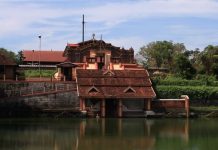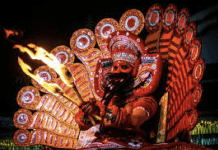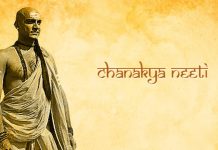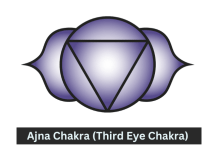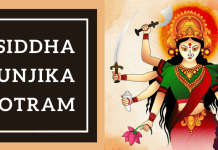The Thanumalayan Suchindram Anjaneyar Temple ( also called Sthanumalayan Perumal Temple) is situated in the Suchindram district of Kanyakumari, approximately 11 km from Kanyakumari. The main deity of the temple is Sri Sthanumalayan, which represents Lord Shiva, Lord Vishnu, and Lord Brahma – making it of significant religious importance to both Shaivite and Vaishnavite devotees. The 22 feet tall statue of Lord Anjaneya is one of the prominent attractions of the temple.
History of Suchindram Temple, Kanyakumari
The Suchindram Temple has a rich history that dates back to the 8th century, with inscriptions that can be traced back to the 9th century. Although the temple was originally built during the 17th century, it is believed that certain parts of the temple were built as early as the 8th century, and some even date back to the 15th century. The temple is renowned for its exquisite sculptures, which were crafted by some of the best artisans of that era.
One of the most notable features of the Suchindram Temple is the 22-foot-tall statue of Lord Hanuman that stands outside the temple. This statue is carved from a single block of granite and was buried in 1740 AD due to fears of an attack from Tipu Sultan. It was later recovered in 1930 and is now open for public viewing.
Before the merger of Kanyakumari into Tamil Nadu, the Suchindram Temple was under the administration of the Travancore Kingdom, with its main temple located at Padmanabhapuram. While Nagercoil, which was formerly under the control of the Cholas, Chera, and Pandya Reign, was primarily a Shaivite region, the Suchindram Temple, being Vaishnavite, presents a unique blend of both sects. The worship at this temple is overseen by the families of Namboodiri Brahmins, adding to its cultural richness.
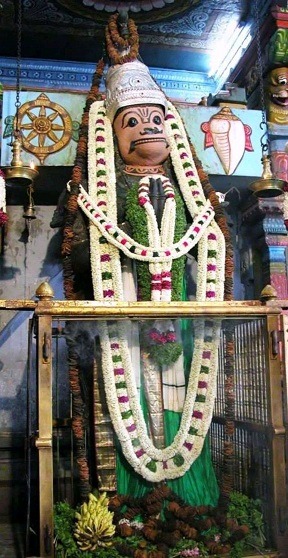
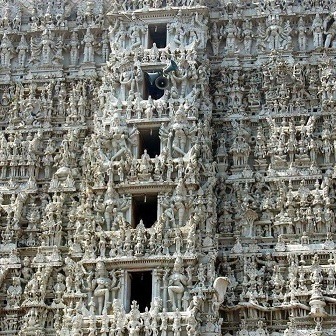
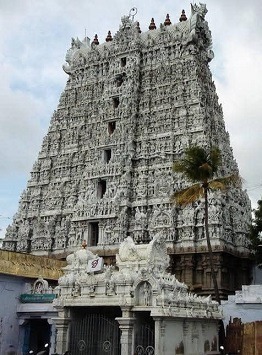
Legend behind Suchindram Temple, Kanyakumari
Suchindram Temple in Kanyakumari is steeped in several legends. One of the most popular stories recounts how the Hindu Trinity, comprising Lord Shiva, Lord Brahma, and Lord Vishnu, once visited the temple. Devi Anusaya, the wife of Sage Atri, lived there, and the Trinity decided to test her. Disguised as three sages, they asked her for food, but upon being offered it, they refused, stating that they would only accept offerings from unclothed individuals. Recognizing the sin of refusing help, Anusaya sprinkled holy water on the sages, and they turned into babies – Shiva as Durvasa, Vishnu as Dattatreya, and Brahma as Chandra. She then fed and cared for them. When the Goddesses Saraswati, Parvati, and Lakshmi learned of this, they requested that Anusaya restore their husbands to their original forms. As they were leaving, the Trinity manifested as Swayambhu Lingas under the Amaltas tree, known as Sthala Vriksham. Another legend connects Suchindram and the town to the Devi Kanyakumari Temple, as Lord Shiva is said to have stayed here before his planned wedding to Devi Kanyakumari. A false crow from Sage Narada, disguised as a rooster, caused Lord Shiva to believe he had missed the auspicious time, so he returned to Suchindram. Finally, there is the story of Agnipariksha, a ritual that was practiced at the temple until the 1860s. It involved dipping the suspected person’s hand into boiling ghee to retrieve a silver ox, and if the person’s hand was unscathed after three days, they were proven innocent. These stories have contributed to the rich cultural and religious significance of Suchindram Temple.
Architecture of Suchindram Temple, Kanyakumari
The Suchindram Temple in Kanyakumari is renowned not just for its religious significance but also for its captivating architecture. Its structural splendor attracts visitors from all over.
The temple features a seven-storied white Gopuram with a portico embellished with exquisitely sculpted images of various deities. This 134-foot-tall Gopuram appears even more stunning when sunlight illuminates it, showcasing the unique architecture styles of South Indian temples. To the right of the temple, there is a massive temple tank which is used for temple activities.
One of the main attractions of the temple is the four musical pillars that stand at a height of 18 feet. These pillars were crafted from a single granite stone and produce various musical notes when struck, providing an exceptional example of architecture.
The temple also features a dancing hall with over 1035 beautifully carved pillars. The main deities of the temple, Sthanu (Lord Shiva), Mal (Lord Vishnu), and Aya (Lord Brahma) are located in the sanctum sanctorum. Additionally, there is a shrine for Lord Vishnu on the side of the sanctum sanctorum, and the idol of the Lord has been made by combining eight different types of metals.
To the right of the sanctum sanctorum is the shrine of Lord Rama and Goddess Sita, while on the left side is the shrine of Lord Ganesha. At the front, there is a Navagraha mandapa. In total, there are approximately 30 shrines in the temple, including those of Kailasanathar, Nataka Sala, Vadakkedam, Kailasattu Mahadeva, Pancha Pandavar, Kontai Adi, Guru Dakshinamurthy, Cheravasal Sastha, Lord Muruga, Garuda, Subramania Swamy, and many others.
The temple’s main attraction is a colossal statue of Lord Hanuman, and “vada mala” pooja is a special ritual performed for this Hanuman effigy. The statue stands at 18 feet tall and represents ‘Visuvaroopam.’ This temple is a prime example of South Indian architecture, and visitors can find a ‘Linga’ that represents Shiva, Vishnu, and Brahma as the supreme deity.
The temple has many sculptures, and the ‘Alankara mandapam’ located next to the arctic passageway comprises four large pillars that are formed by a couple of smaller beams, all of which are engraved from a single stone. The temple’s statue of Hanuman and musical pillars are the main attractions.
The massive 22-foot-tall idol of Lord Hanuman carved from a single granite rock is sure to captivate every devotee. This statue is one of the largest in India and was hidden in the temple due to fears of attacks from Tipu Sultan. In 1930, it was discovered and subsequently restored to its former glory. Another striking aspect of the temple is the carving of Vinayaki (Female Vinayaka), and the majestic image of Nandi, the vehicle of Lord Shiva, which stands at 13 feet tall, 21 feet long, and 10 feet wide.
Suchindram Temple Festivals
The temple’s most famous festival is the 10-day long car festival, which takes place in December or January. The temple attracts thousands of people during the car festival, where special worship practices are followed, and festival images of Sthanumalayan, Aram valartha Nayagi, and Vinayagar are taken in the temple car around the streets. Other significant celebrations include the Avani Festival in August, Chithirai Festival in April, and Masi Festival in March.
Timings of Suchindram Temple, Kanyakumari
The morning darshan timings are from 4:30 AM to 11:30 AM, and the evening darshan timings are from 5:00 PM to 8:30 PM.
How to Reach Suchindram Temple, Kanyakumari
By Air:
The nearest airport to Suchindram Temple is the Trivandrum International Airport, which is around 70 km away. From the airport, you can hire a taxi or take a bus to reach the temple.
By Train:
The nearest railway station to Suchindram Temple is Kanyakumari Railway Station, which is around 11 km away. From the station, you can take a taxi or a bus to reach the temple.
By Bus:
Suchindram is well-connected by road to major cities in Tamil Nadu and Kerala. There are regular bus services from Kanyakumari, Trivandrum, Chennai, Madurai, and other nearby cities.
By Car/Taxi:
You can also hire a car or taxi from nearby cities like Kanyakumari, Trivandrum, and Madurai to reach Suchindram Temple.



